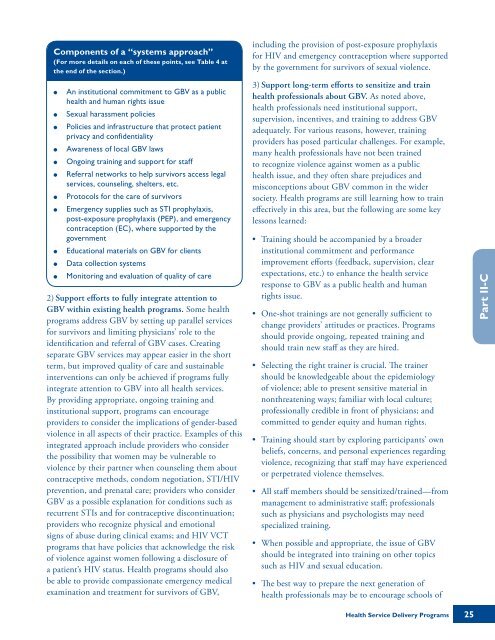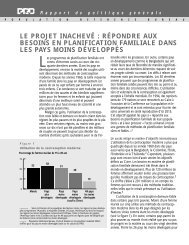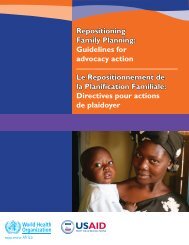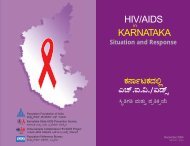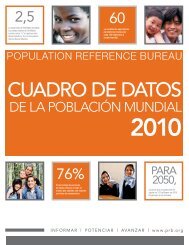addressing gender-based violence through usaid's health ... - IGWG
addressing gender-based violence through usaid's health ... - IGWG
addressing gender-based violence through usaid's health ... - IGWG
Create successful ePaper yourself
Turn your PDF publications into a flip-book with our unique Google optimized e-Paper software.
Components of a “systems approach”<br />
(For more details on each of these points, see Table 4 at<br />
the end of the section.)<br />
●<br />
●<br />
●<br />
●<br />
●<br />
●<br />
●<br />
●<br />
●<br />
●<br />
●<br />
An institutional commitment to GBV as a public<br />
<strong>health</strong> and human rights issue<br />
Sexual harassment policies<br />
Policies and infrastructure that protect patient<br />
privacy and confidentiality<br />
Awareness of local GBV laws<br />
Ongoing training and support for staff<br />
Referral networks to help survivors access legal<br />
services, counseling, shelters, etc.<br />
Protocols for the care of survivors<br />
Emergency supplies such as STI prophylaxis,<br />
post-exposure prophylaxis (PEP), and emergency<br />
contraception (EC), where supported by the<br />
government<br />
Educational materials on GBV for clients<br />
Data collection systems<br />
Monitoring and evaluation of quality of care<br />
2) Support efforts to fully integrate attention to<br />
GBV within existing <strong>health</strong> programs. Some <strong>health</strong><br />
programs address GBV by setting up parallel services<br />
for survivors and limiting physicians’ role to the<br />
identification and referral of GBV cases. Creating<br />
separate GBV services may appear easier in the short<br />
term, but improved quality of care and sustainable<br />
interventions can only be achieved if programs fully<br />
integrate attention to GBV into all <strong>health</strong> services.<br />
By providing appropriate, ongoing training and<br />
institutional support, programs can encourage<br />
providers to consider the implications of <strong>gender</strong>-<strong>based</strong><br />
<strong>violence</strong> in all aspects of their practice. Examples of this<br />
integrated approach include providers who consider<br />
the possibility that women may be vulnerable to<br />
<strong>violence</strong> by their partner when counseling them about<br />
contraceptive methods, condom negotiation, STI/HIV<br />
prevention, and prenatal care; providers who consider<br />
GBV as a possible explanation for conditions such as<br />
recurrent STIs and for contraceptive discontinuation;<br />
providers who recognize physical and emotional<br />
signs of abuse during clinical exams; and HIV VCT<br />
programs that have policies that acknowledge the risk<br />
of <strong>violence</strong> against women following a disclosure of<br />
a patient’s HIV status. Health programs should also<br />
be able to provide compassionate emergency medical<br />
examination and treatment for survivors of GBV,<br />
including the provision of post-exposure prophylaxis<br />
for HIV and emergency contraception where supported<br />
by the government for survivors of sexual <strong>violence</strong>.<br />
3) Support long-term efforts to sensitize and train<br />
<strong>health</strong> professionals about GBV. As noted above,<br />
<strong>health</strong> professionals need institutional support,<br />
supervision, incentives, and training to address GBV<br />
adequately. For various reasons, however, training<br />
providers has posed particular challenges. For example,<br />
many <strong>health</strong> professionals have not been trained<br />
to recognize <strong>violence</strong> against women as a public<br />
<strong>health</strong> issue, and they often share prejudices and<br />
misconceptions about GBV common in the wider<br />
society. Health programs are still learning how to train<br />
effectively in this area, but the following are some key<br />
lessons learned:<br />
• Training should be accompanied by a broader<br />
institutional commitment and performance<br />
improvement efforts (feedback, supervision, clear<br />
expectations, etc.) to enhance the <strong>health</strong> service<br />
response to GBV as a public <strong>health</strong> and human<br />
rights issue.<br />
• One-shot trainings are not generally sufficient to<br />
change providers’ attitudes or practices. Programs<br />
should provide ongoing, repeated training and<br />
should train new staff as they are hired.<br />
• Selecting the right trainer is crucial. The trainer<br />
should be knowledgeable about the epidemiology<br />
of <strong>violence</strong>; able to present sensitive material in<br />
nonthreatening ways; familiar with local culture;<br />
professionally credible in front of physicians; and<br />
committed to <strong>gender</strong> equity and human rights.<br />
• Training should start by exploring participants’ own<br />
beliefs, concerns, and personal experiences regarding<br />
<strong>violence</strong>, recognizing that staff may have experienced<br />
or perpetrated <strong>violence</strong> themselves.<br />
• All staff members should be sensitized/trained—from<br />
management to administrative staff; professionals<br />
such as physicians and psychologists may need<br />
specialized training.<br />
• When possible and appropriate, the issue of GBV<br />
should be integrated into training on other topics<br />
such as HIV and sexual education.<br />
• The best way to prepare the next generation of<br />
<strong>health</strong> professionals may be to encourage schools of<br />
Part II-C<br />
Health Service Delivery Programs<br />
25


